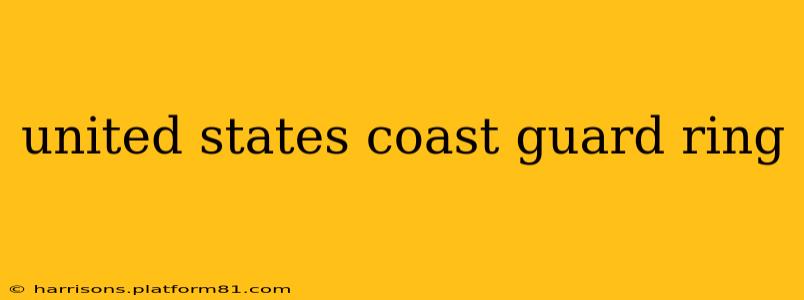The United States Coast Guard ring is more than just jewelry; it's a powerful symbol of dedication, service, and shared experience within a proud and historic organization. For those who have earned the right to wear one, it represents years of commitment, rigorous training, and unwavering loyalty to the Coast Guard's mission. This article delves into the significance of these rings, exploring their history, design elements, and the meaning they hold for recipients.
What is the Significance of a US Coast Guard Ring?
The Coast Guard ring signifies membership in a select group of individuals who have dedicated their lives to protecting the nation's waterways and ensuring maritime safety. It's a tangible representation of the values upheld by the Coast Guard: honor, respect, devotion to duty, and selfless service. Wearing the ring is a visible demonstration of pride in one's service and a connection to the rich history and traditions of the Coast Guard.
What Makes a US Coast Guard Ring Unique?
Unlike typical class rings, the Coast Guard ring features unique design elements that reflect the organization's history and identity. These elements often include:
- The Coast Guard Emblem: Prominently displayed, usually on the face of the ring.
- The Coast Guard Seal: Often incorporated into the design, representing the organization's authority and mission.
- Semper Paratus: The Coast Guard motto, meaning "Always Ready," is frequently inscribed, embodying the service's constant state of preparedness.
- Individualization Options: While maintaining a core design consistent with Coast Guard tradition, individuals often have options for personalization, such as adding graduation year or unit insignia.
The materials used, such as gold or other precious metals, add to the ring's inherent value and reflect its significance. The weight and feel of the ring itself contribute to the sense of prestige associated with it.
Who is Eligible to Receive a US Coast Guard Ring?
Eligibility for a US Coast Guard ring typically varies depending on the specific program or branch of service. While exact criteria may change over time, it generally involves:
- Graduation from the Coast Guard Academy: Graduates of this prestigious institution are often among the first to receive a ring.
- Completion of Officer Candidate School (OCS): Newly commissioned officers often mark this significant milestone with a ring.
- Years of Service: Some Coast Guard members may be eligible to receive a ring after serving a certain number of years, acknowledging their long-term commitment and contributions.
It's crucial to consult official Coast Guard resources or relevant personnel for the most up-to-date and accurate information regarding eligibility requirements.
How Much Does a US Coast Guard Ring Cost?
The cost of a US Coast Guard ring can vary depending on the materials used, the level of customization, and the vendor. Since these rings are often produced by specialized jewelers, prices tend to be higher than average class rings. Potential recipients should research various vendors and compare prices before making a purchase.
Where Can I Buy a US Coast Guard Ring?
While the Coast Guard doesn't directly sell the rings, various jewelers have been authorized or are affiliated with providing these to eligible personnel. The best approach is to inquire within the Coast Guard or contact a reputable jeweler specializing in military and service academy rings.
Are there Different Styles of US Coast Guard Rings?
While maintaining a core design reflecting the Coast Guard’s emblem and motto, subtle variations in style and design may exist depending on the year of graduation, individual preferences (where allowed), and the jeweler. However, these are generally minor differences within a consistent overall aesthetic.
This comprehensive overview aims to provide a detailed understanding of the United States Coast Guard ring, its symbolism, and its importance within the Coast Guard community. Remember to always consult official sources for the most accurate and updated information regarding eligibility and procurement.
